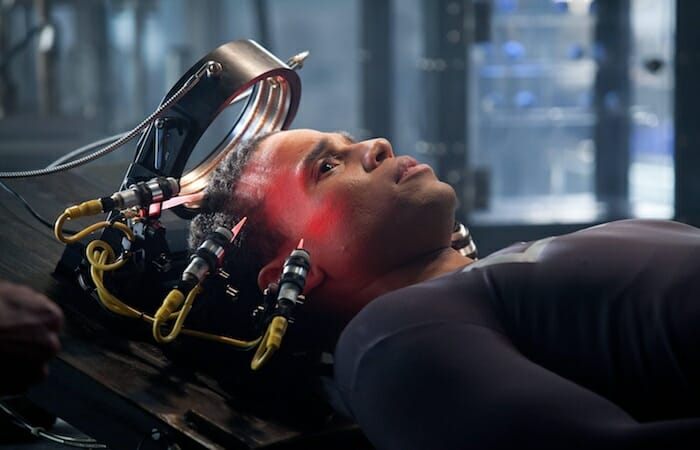By Becky Kifer · November 20, 2013

The geeky genesis of a hit cult show is one percent aspiration and ninety-nine percent anticipation—except when the eagerness backfires and we’re left making excuses. (See Agents of But It’s Getting Better S.H.I.E.L.D.).
If expectations alone were the key to success, Fox’s techo-futuristic-nerd-bait Almost Human would be doing rocket-boot powered pirouettes over NCIS. Between bus stop billboards and the publicity of having the show’s premiere pushed back two weeks, Fox hit the advertising ground running. Even J.J. Abrams’ name—arbitrarily attached to another glossy sci-fantasy fusion project—is a draw. Yet anticipation and expectation have a nasty habit of colliding, turning the final product into an interesting, if contradicting, patchwork program.
As Almost Human begins, the opening voiceover tells us that the year is 2048 and technically has expanded beyond regulation, causing crime to spike 400%. (That’s like going from Mayberry to Gotham over a weekend.) Outnumbered by criminals, cops are now partnered with androids to help keep the peace. Decorated Los Angeles cop John Kennex (Karl Urban), severely injured during a brutal ambush, has returned to the police force and is expected to play by the new rules. After throwing his first machine partner out of a moving vehicle (a cute gag as the annoying robo-cop is smashed under a truck; an irritating gag when you think about the fact that it could have easily been a car full of, say, children), John is assigned a decommissioned android named Dorian (Michael Ealy).
A model considered too unstable due to its human-esque subroutines, Dorian is nothing like his synthetic brethren, who are logic-based and lacking in both creativity and freewill. Together John and Dorian work to stop an organization called the Syndicate, a group that, for reasons yet unknown, is looking to not only steal something from the police station’s evidence lockup but murder the city’s cops using chemical weapons. (You need to have the chemical sprayed directly in your face to actually die, though. If you’re in the same room or just an open stairwell up from the dispersion, no worries—deadly airborne toxins totally have a five feet radius of safety. )
Almost Human, perhaps more than any premiere this year, desperately needed a two-part pilot. The breakneck speed of the story left no indelible mark of interest and most of the questions waiting to be answered—Who is John’s ex-girlfriend and why was she present at the ambush? What does the robotic head in the evidence locker mean to the Syndicate?—are all dropped in the second episode in the name of getting the procedural train a ‘rolling. (The show was advertised as having a two-night premiere, but really it was just two unconnected episodes airing 24 hours apart.) They’ll get back to it, but the momentum is DOA.
TV has a long history of wacky partnerships. Serious white guy, cheeky white guy; person with XX chromosomes, person with XY chromosomes; handsome dude and mysterious feline delivering prophetic newspapers. The buddy dynamic has almost reached its peak—within two years I’m expecting K-9 The Series: Crime Doesn’t Paws starring Jim Belushi—so it’s only fitting that we’ve now moved on to man and Cylon.
Of the two leads, Urban has the bigger Hollywood profile, but it’s Ealy who walks off with the show. Dorian is huggable formality—one part Data, two parts WALL-E. He breaks the rules of robotics, while still acting far more human than any of the actual mortals on the show. Urban’s grousing old-school cop shtick is blandly familiar. “They killed my team… my friends…” he growls in the pilot, sounding like he ruptured a tonsil just to get the line out. It’s not that Urban isn’t great at grumpy; I’m pretty sure that barracuda scowl could send a stone gargoyle fleeing. I’m just looking forward to when he gets to add in more crotchety nuisance to the character. (Thankfully in the second episode this tin man gets to prove he has a heart as he rather sweetly gathers information from a young witness.)
Other than some astounding advancement in robotics and bio-chemical warfare, Almost Human is mostly grounded in realism, with the biggest indication of the “future” being an abundance of neon lights. And monorails; lots and lots of monorails. Cell phones look like they’re only at an iPhone 8 level, Google Glass clearly flopped, and vehicles still seem to be mostly wheel-based. (In the pilot the cars are all either CGI or 2013 models wrapped in black plating. By the second episode, they seem to have given up the guise as the driving stock shots are full of current-day cars.) This type of verism is great, but boring in a world brimming with science fiction potential.
In many ways the second episode, even with an eye-roll worthy prosti-bots storyline, did a far better job of establishing the tone of the series than its predecessor. A little mirth can go a long way, especially as the pilot set the series up as a bleak, dystopian adventure that seemed to only showcase the drudges of society. (When you make The Walking Dead look perky by comparison, you know there’s a problem.)
Almost Human sells itself—it only needs to remember it also has to sell its viewers not just on a world weighed down by crime and corruption, but in an existence where human beings (and AI’s like Dorian) can keep moving forward. A few more calibrations and the series—if Fox plays its cards right—might have a future worth talking about.